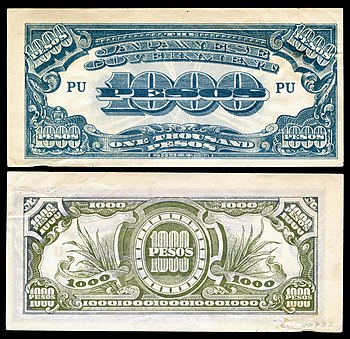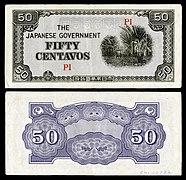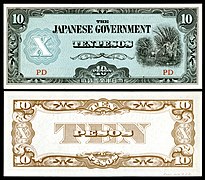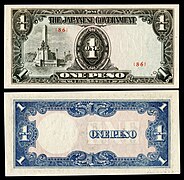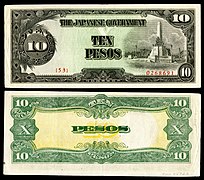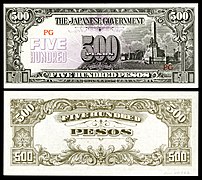Talk:Japanese government–issued Philippine peso
| This article is rated Start-class on Wikipedia's content assessment scale. It is of interest to the following WikiProjects: | ||||||||||||||||||||||||||||||||||||||
| ||||||||||||||||||||||||||||||||||||||
| On 29 January 2023, it was proposed that this article be moved from Japanese government-issued Philippine peso to Japanese government–issued Philippine peso. The result of the discussion was moved. |
Original Article
[edit]Wrote original article. Kguirnela 07:06, 15 November 2006 (UTC)
Did anyone else notice this?
[edit]My grandmother just found some of these in her house and I got to see them. I had no idea why the Japanese government would issue such currency until I googled it and ended up here. Anyway, while looking at it, I noticed that on the bottom of the 5 it said ソペ (sope). It obviously should say ペソ (peso) and I was wondering how the Japanese could mess up their own language. The same occurs on the other bills but in different places. 71.214.249.162 (talk) 02:56, 29 July 2009 (UTC)
- It could have been possible that they switched the characters around during the printing process... (my non-expert opinion). — •KvЯt GviЯnЭlБ• Speak! 06:19, 30 July 2009 (UTC)
Facts Must Be Substantiated. No Original Research, Please
[edit]Statements about the currency "being worthless" are potentially misleading. The extremely high prices of eggs could be due to wartime shortage, having little to do with one currency or another. Such statements must be substantiated or removed. TippTopp (talk) 18:11, 5 July 2011 (UTC)
- Extremely high prices cause inflation, which necessarily make the currency become worthless. So the extremely high prices are a cause (and also a symptom) of the worthlessness of the currency. Faunas (talk) 15:51, 10 November 2012 (UTC)
External links modified
[edit]Hello fellow Wikipedians,
I have just added archive links to one external link on Japanese government-issued Philippine peso. Please take a moment to review my edit. If necessary, add {{cbignore}} after the link to keep me from modifying it. Alternatively, you can add {{nobots|deny=InternetArchiveBot}} to keep me off the page altogether. I made the following changes:
- Added archive https://web.archive.org/20090217145642/http://www.latimes.com:80/news/local/valley/la-tr-philippines7aug07,0,648886,full.story?coll=la-editions-valley to http://www.latimes.com/news/local/valley/la-tr-philippines7aug07,0,648886,full.story?coll=la-editions-valley
When you have finished reviewing my changes, please set the checked parameter below to true to let others know.
This message was posted before February 2018. After February 2018, "External links modified" talk page sections are no longer generated or monitored by InternetArchiveBot. No special action is required regarding these talk page notices, other than regular verification using the archive tool instructions below. Editors have permission to delete these "External links modified" talk page sections if they want to de-clutter talk pages, but see the RfC before doing mass systematic removals. This message is updated dynamically through the template {{source check}} (last update: 5 June 2024).
- If you have discovered URLs which were erroneously considered dead by the bot, you can report them with this tool.
- If you found an error with any archives or the URLs themselves, you can fix them with this tool.
Cheers.—cyberbot IITalk to my owner:Online 08:30, 18 January 2016 (UTC)
1944 Japanese government pesos value in USA now
[edit]I would like to know if it is real and how much it is worth in the United States and if I can exchange it for cash in America Jtwhite7669 (talk) 00:13, 30 March 2019 (UTC)
- They have a pretty small value to collectors (they're pretty common, although there might be some rare variants I'm unaware of). Otherwise they're worthless.
- I have a framed set of these Japanese notes, several currencies from several areas, most of the denominations. It's an interesting collectible, but it didn't cost me more than a few bucks to put together. Andy Dingley (talk) 00:20, 30 March 2019 (UTC)
File:PHI-115-Japanese Government (Philippines)-1000 Pesos (1945).jpg to appear as POTD soon
[edit]Hello! This is a note to let the editors of this article know that File:PHI-115-Japanese Government (Philippines)-1000 Pesos (1945).jpg will be appearing as picture of the day on December 11, 2019. You can view and edit the POTD blurb at Template:POTD/2019-12-11. If this article needs any attention or maintenance, it would be preferable if that could be done before its appearance on the Main Page so Wikipedia doesn't look bad. :) Thanks! Cwmhiraeth (talk) 11:38, 30 November 2019 (UTC)
This picture shows the obverse (top) and reverse (bottom) sides of a 1000-peso note that was issued in 1945, shortly before the country was liberated by Allied troops. The banknote is in the National Numismatic Collection of the Smithsonian Institution's National Museum of American History.Banknote credit: Empire of Japan; photographed by Andrew Shiva
Featured picture scheduled for POTD
[edit]Hello! This is to let editors know that File:PHI-102b-Japanese Government (Philippines)-1 Centavo (1942).jpg, a featured picture used in this article, has been selected as the English Wikipedia's picture of the day (POTD) for January 28, 2023. A preview of the POTD is displayed below and can be edited at Template:POTD/2023-01-28. For the greater benefit of readers, any potential improvements or maintenance that could benefit the quality of this article should be done before its scheduled appearance on the Main Page. If you have any concerns, please place a message at Wikipedia talk:Picture of the day. Thank you! Adam Cuerden (talk)Has about 7.9% of all FPs 23:36, 30 May 2022 (UTC)
The Japanese government-issued Philippine peso was a fiat currency issued in the Philippines during World War II, by the occupying Japanese government. One of several examples of Japanese invasion money, the currency was issued in several denominations and was known by some Filipinos by the derogatory term "Mickey Mouse money". The effect of wartime hyperinflation towards the end of the war can be seen in the rapid increase of denomination values that were put into circulation. These thirteen banknotes were issued in ten denominations from one centavo to one thousand pesos by the Japanese government and are now part of the National Numismatic Collection at the Smithsonian Institution. Banknote design credit: Empire of Japan
Recently featured:
|
Requested move 29 January 2023
[edit]- The following is a closed discussion of a requested move. Please do not modify it. Subsequent comments should be made in a new section on the talk page. Editors desiring to contest the closing decision should consider a move review after discussing it on the closer's talk page. No further edits should be made to this discussion.
The result of the move request was: moved. No opposition after two weeks. (closed by non-admin page mover) Sceptre (talk) 20:15, 16 February 2023 (UTC)
- Japanese government-issued Philippine peso → Japanese government–issued Philippine peso
- Japanese government-issued rupee in Burma → Japanese government–issued rupee in Burma
- Japanese government-issued dollar in Malaya and Borneo → Japanese government–issued dollar in Malaya and Borneo
- Japanese government-issued currency in the Dutch East Indies → Japanese government–issued currency in the Dutch East Indies
- Japanese government-issued Oceanian pound → Japanese government–issued Oceanian pound
– Per MOS:SUFFIXDASH. They were issued by the Japanese government, not just by government. This is kinda controversial (e.g. Post-traumatic stress disorder, according to MOS:PREFIXDASH (which is the same as SUFFIXDASH but with prefixes), should be located at Post–traumatic stress disorder since the disorder comes after traumatic stress, not just a trauma) so I decided to start an RM. —hueman1 (talk • contributions) 12:11, 29 January 2023 (UTC) — Relisting. – robertsky (talk) 17:04, 7 February 2023 (UTC)
- Note: WikiProject Indonesia, WikiProject Japan, WikiProject Malaysia, WikiProject Military history, WikiProject Myanmar, WikiProject Numismatics, WikiProject Oceania, WikiProject Singapore, WikiProject Southeast Asia, and Tambayan Philippines have been notified of this discussion. —hueman1 (talk • contributions) 01:05, 30 January 2023 (UTC)
- Comment This is first time I've heard of this convention for using an en dash. Not necessarily opposed or supportive at this time, but can you elaborate on the origin of this usage and the positions of the major manuals of style on it? —Arsonal (talk + contribs)— 21:12, 30 January 2023 (UTC)
- @HueMan1: could you comment on this? Elli (talk | contribs) 22:50, 6 February 2023 (UTC)
- @Arsonal and Elli: According to Merriam-Webster: If you want to be official about things, use the en dash to replace a hyphen in compound adjectives when at least one of the elements is a two-word compound.
the post–Cold War era
- The thinking is that using a hyphen here, as in "the post-Cold War era," risks the suggestion that post attaches only to Cold. It's unlikely, though, that a reader would truly be confused.
- The Chicago Manual of Style: En dashes are also used to connect a prefix to a proper open compound: for example, pre–World War II. In that example, "pre" is connected to the open compound "World War II" and therefore has to do a little extra work (to bridge the space between the two words it modifies—space that cannot be besmirched by hyphens because "World War II" is a proper noun).
- and the Microsoft Style Guide: Use an en dash (–) instead of a hyphen in a compound modifier when:
One element of the modifier is an open compound.
- Examples
- Windows 10–compatible products
- dialog box–type options
- Two or more of the elements are made up of hyphenated compounds (a rare occurrence).
- —hueman1 (talk • contributions) 01:39, 7 February 2023 (UTC)
- @HueMan1: could you comment on this? Elli (talk | contribs) 22:50, 6 February 2023 (UTC)
- Comment I too have never heard of this. Wikipedia doesn't necessarily follow Chicago Style, or any other style. I would just be WP:BOLD and move them. However, I really have no strong opinions other way. EmeraldRange (talk/contribs) 21:38, 11 February 2023 (UTC)
— Relisting. ❯❯❯ Raydann(Talk) 06:30, 15 February 2023 (UTC)
- Start-Class numismatic articles
- Mid-importance numismatic articles
- WikiProject Numismatics articles
- Start-Class Philippine-related articles
- Mid-importance Philippine-related articles
- WikiProject Philippines articles
- Start-Class Japan-related articles
- Low-importance Japan-related articles
- WikiProject Japan articles





